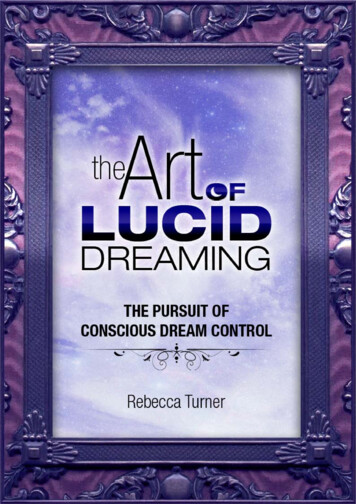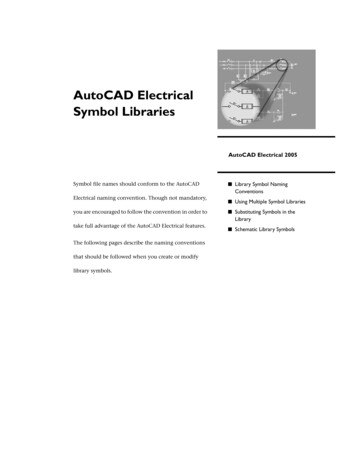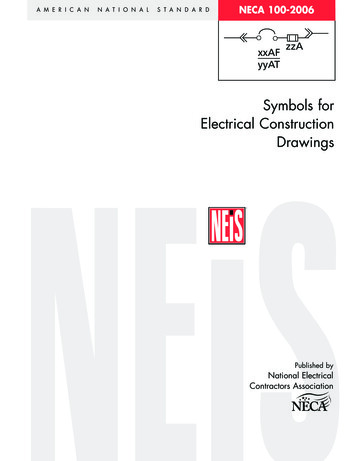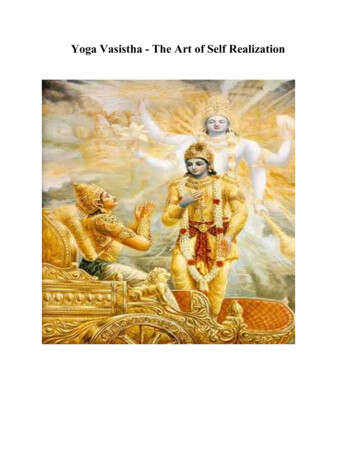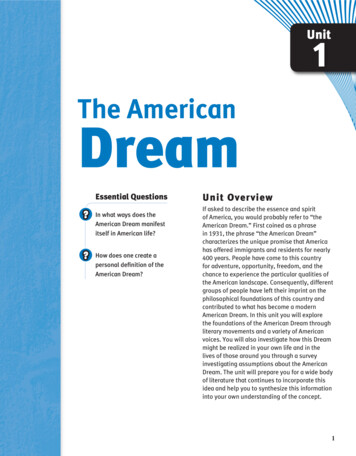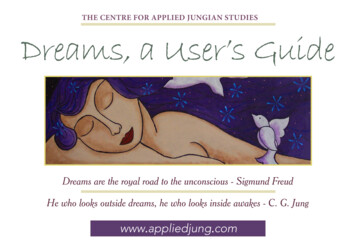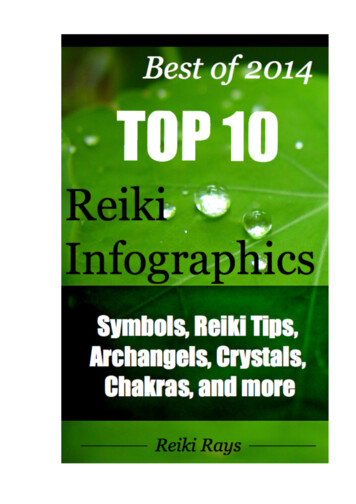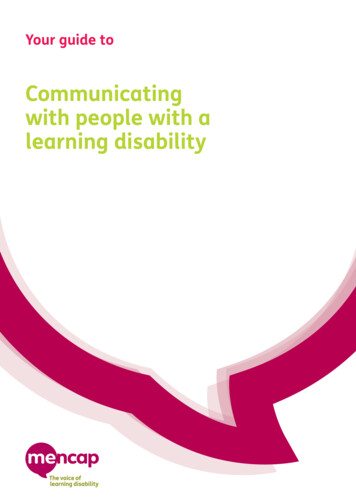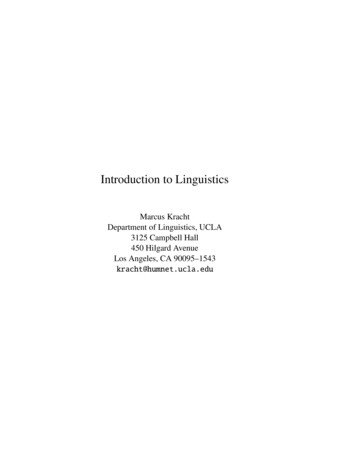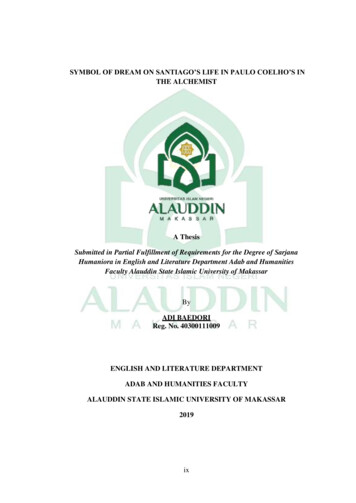
Transcription
SYMBOL OF DREAM ON SANTIAGO’S LIFE IN PAULO COELHO’S INTHE ALCHEMISTA ThesisSubmitted in Partial Fulfillment of Requirements for the Degree of SarjanaHumaniora in English and Literature Department Adab and HumanitiesFaculty Alauddin State Islamic University of MakassarByADI BAEDORIReg. No. 40300111009ENGLISH AND LITERATURE DEPARTMENTADAB AND HUMANITIES FACULTYALAUDDIN STATE ISLAMIC UNIVERSITY OF MAKASSAR2019ix
x
xi
xii
xiii
xiv
xv
TABLE OF CONTENTHALAMAN JUDUL.iHALAMAN PERNYATAAN KEASLIAN SKRIPSI .iiHALAMAN PERSETUJUAN PEMBIMBING .iiiAPPROVAL.ivHALAMAN PENGESAHAN SKRIPSI .vACKNOLEDGMENT.viTABLE OF CONTENTS .ixABSTRACT .xiiCHAPTER I INTRODUCTIONA. Background .1B. Problem Statement .3C. Objective of the Research .3D. Significance of the Research .3E. Scope of the Research .3CHAPTER II REVIEW OF RELATED LITERATUREA. Previous Findings .4B. Semiotics .5C. Charles Sanders Pierce’s Semiotic Theorys .6D. Kind of Symbol .7E. Symbols .8F. Novel .10G. Synopsis .10xvi
H. Biography of Paulo Coelho.12CHAPTER III RESEARCH METHODOLOGYA. Research Method.13B. Source of Data .13C. Procedure of Data Collection .13D. Technique of Data Analysis .14CHAPTER IV FINDINGS AND DISCUSSIONSA. Findings .15B. Discussions .16CHAPTER V CONCLUSIONS AND SUGGESTIONSA. Conclusions .31B. Suggestions .32BIBLIOGRAPHY .34xvii
18
BAB IINTRODUCTIONA. BackgroundSymbol, word, or any sign system has meanings. Two eras may have thesame symbols but the symbols may have different meanings or namings. Forexample, an image of a fish means an astrological symbol (zodiac), on the otherhand, for Christians, they understood it is a symbol that means following Jesusand sharing the message of His love. It means that symbols are historical culturalconstruct. We can assess the symbols meanings based on their historical andcultural context.According to Bachry (1993; 95) symbol or sign is something like,drawing, speech, emblem, etc, which explain or contain meanings for instancewhite for holiness, and rice is a symbol of wealth. There are two kinds ofsymbols: literary and arbitrary symbols. Symbols contain expended viewtherefore; if we are discussing the significance of the literary work, we talk aboutthem as symbols.According to Roland Barthes in Nauta (2005:10) symbol is sign, (specificthing) which is used to facilitate communication between people. Yet, symbol isnot autonomous, it is always related to culture.Keep in mind that literary works are imaginative works, both oral andwritten, fictitious, even though the material or inspiration is taken from the worldof real, which has been processed by the author so that it cannot be expected thatreality is the same as real world reality ( Noor, 2004:11).1
The writer can conclude that symbol has different meaning in differentculture. For example : in Makassar’s culture, to show their family is dead, theywave white flag, but in Bali’s culture they wave yellow flag if their family is dead.This novel entitled the Alchemist, by Paulo Coelho, a novelist who livesin Sao Paulo, Brazil. Therefore the novel requires interpretation, because it rapidlycontains symbols, but often readers do not know it and do not understand what thewriter actually writes through his work. The writer analyzes the alchemistnovel which tells about a boy named Santiago. He is a sheep shepherd. When hewas a child, his parents sent him to a local school in Spain. His parents hoped thathe would be a pastor and made his parents proud. Unfortunately, he did not wantto be a pastor. He told his father that he wanted to be a shepherd. His father wasdisappointed, but he could not force him to be a pastor. Then, his father boughthim 60 sheep. Every day he went to savannah to feed his sheep. In theAlchemist’s novel, Coelho uses symbols to tell the journey of a shepherd boy.Starting with a little prologue about Narcissus and the lake, then the story divertedto the story of Santiago’s journey trying to reach his dream. This child dreams oftreasure in the Egyptian Pyramid. He dreams the same twice in his sleep, and itbring him to enter a new world that he never thought before.Especially the novel presents two main symbols that often appear in eachstory telling. These symbols help develop Santiago’s innocent personality so itchanges to be wiser and more understand life.The writer is interested in analyzing the novel because it can show thatthere are many symbols in occurring dreams.2
B. Problem StatementBased on the explanation in the background of the study above, theresearcher formulates the research questions as follows:1. What are the symbols used in the novel the Alchemist?2. What are the meanings of those symbols in the novel Alchemist?C. Objectives of The ResearchBased on the research questions above, the objectives of the study are:1. To analyze the symbols used in the novel the Alchemist.2. To analyze the meaning of those symbols in the novel Alchemist.D. Significance of The ResearchPractically the researcher expects that this study will give contributionto students majoring in literature, to novel’s lovers, and to psychologist inanalyzingthe relation of somebody’s symbol of dreams. Theoretically, theresearcher hopesthat it could give advantages to literature development inimproving the knowledge about the semiotics.E. Scope of The ResearchIn this study, the researcher only discusses the symbols of dreamthrough the novel.3
BAB IIREVIEW OF RELATED LITERATUREA. Previous FindingsIn this section, the writer presented some previous findings ofresearch which have relation with this research.Rosida (2007) in her thesis “ The analysis of symbol in the novel “TheScarlet Letter” by Nathaniel Hawthorne”. In her thesis she analyzes study usesemiotic approach because this analysis about symbol in the novel. The data wereanalyzed by using Richard’s theory.Hikmah (2008) in her thesis “The Power Of Symbols In JalaluddinRumi’s Prose “Fihi Ma Fihi” ( It is what it is)”. In her thesis she analyzed byHermeneutics and Semiotic Approach Those symbols reflected self unity to Allahfor most creator, and also embody “wahda al wujud” unity of existence.Melani (2010) in her thesis, “Analyze the Symbol in The Da Vinci Codenovel by Dan Brown”. She focus in descriptive qualitative analysis used toexplain kids of symbols that found in this novel.Based on the above thesis there is a similarity to the title whichthe writer will be analyze. The similarity among those previous researchersabove with this research is to figure out the kinds of symbols are the branch ofsemiotic that containing in literary works. While the differences among them withthis research can be seen from the object of the research. Rosida, in her thesisanalyzing the symbols containing in the novel “ The Scarlet Letter by NathanielHawthorne” by using Richard’s theory. Melani, in her thesis analyzing and4
explaining the kids of symbols containing in the novel “ The Da Vinci Code byDan Brown” by using Revsina’s theory. The last, Hikmah in Jalaluddin Rumi’sProse “Fihi Ma Fihi” (It is what it is) by using Hermeneutics and semioticapproaches. And this research it self focusing on Symbols of dream on Santiago’slife in Paulo Coelho’s The Alchemist by using Pierce’s theory.B. SemioticsThe semiotics tradition begins with a linguist named Ferdinand deSaussure and then followed by Charles sanders Peirce and Umberto Eco. WhereasBarthes prefers to use the term semiology in analyzing these signs. The semioticsproposed by Saussure turned out has a little difference, because Saussure’ssemiotics is semiotic in structure based on general linguistics, while Peirce’ssemiotic is analytical which is based on philosophy.Semiotics is a branch of science that deals with mark assessment andeverything related to signs, such as sign and system the process that applies tosign users ( Van zoest, 1993:1).Signs there can also be anything that in a human life, because of signs issomething else that can be experience, thoughts, feelings, ideas, and others (Nurgiyantoro, 2005:40). After being classified, the sign is interpreted to producean understanding of the novel text.Etymology: from “semeion” ( Greek, “sign) Semiotics is a field ofreseach that studies signs as an essential part of cultural life and communication.According to Jacobson’s ( 1976: 47) semiotics, we can only know culture (andreality) by means of signs, through the processes of signification.5
C. Charles Sanders Pierce’s Semiotic TheoryIn this chapter the researcher used Charles Sanders Pierce’s theory, he isone of the popular philosophers that give an attention to semiotics study so, theresearcher used his theory. Charles Sanders Pierce’s was an AmericanPhilosopher, he was born in Cambridge, Massachusetts on 10 th September 1839,and died in Milford, Pennsylvania on 19th April 1914 (aged 74).pierce gives the definition of the semiotic as sign of something and it isunderstood by someone or has a meaning to someone. Pierce has stated that thesigns are independent to influence somebody in some respect or capacity.To analyze the symbol contained in the novel Alchemist, the researcherwill use the semiotic analysis Peirce. Then Peirce’s semiotics in Wardoyo (2005:3 ), classifying signs into three types, namely: icon, index, and symbol. Andhe separates two triads:1. Pierce’s First Triad: Sign, Interpretant, ObjectSign is something we perceive, and which represents something else.According to Pierce there are many kinds of signs (Pierce separated66 classes of signs). The sign trigger’s in the observer’s mindanother kind of mental sign, the interpretant. The sign stands forsomething in the real world, the object (or referent).2. Pierce’s Second Triad’s: Icon, Index, Symbol.a. Icon, which has natural relation between signifier and signified.For example: man and the picture of women6
b. Index, which has casual relation of signifier and signified, forexample: smoke is sign of firec. Symbol, is sign which has arbitrary or convensional relationbetween signifier and signified, for example: coffin is symbol ofdeath.what usually goes for a sign for regular conversation Pierce called arepresentament. Pierce did so, in order to recognize the representament from theother two signs components, that as we might note, can ended up signs in theirclaim right. The representament is something that enters into connection with isobject, the second component of the sign. The third component of the sign is theinterpretant. It is grenerally talking and adequate for our reason, near to what wewould as a rule takes as the sign’s meaning.D. Kind of SymbolA symbol can be defined in the following way according to Gill Richard( 1995 :13)a. Traditional SymbolMost symbols are tradition, the more we read ( and talk toreaders of poetry) the more we will become acquainted with howword functions symbol call. For instance: there are many symbolsfor death-sleep, sunset, the reaper and many associated with whatlies beyond death, such as a river reaching the see or making ajourney from which there is not return. Other frequently used7
symbols are: flowers for the shortness of life, bird for the soul, agarden for a perfect order. Those are just a few as we read anddiscuss literature, we will become aware of how writer give asymbolic life to many of their life.b. New SymbolIn some cases, a poet makes new symbol. For years TheAncient City of Byzantium was a symbol of the perfect blending ofthe arts of living and the visual arts ( or what is sometimes called artand nature).According to Revsina (1915: 68) kinds of symbol are:a. Objects, usually the symbols we find in the literature are inanimateobject.Such as glass, rose, ring, chair, and etc.b. Characters, symbolic characters in some fiction or plays are not wellrounded and fully known, but are seen fleetingly and remain slightlymysterious.c. Sense, sometimes a symbol addresses a sense rather than sight.d. Setting, in fiction, feature or physical photograph can provide richsuggestion.e. Action, a symbolic act is a gesture with large significant than usual.E. SymbolThe Alchemist is a novel full of symbols. Using these symbols by Coelhoaccording to the writer were presented to make readers understand the message8
they want to convey, but when the opposite happens, readers often don’tunderstand the symbols.The word “symbol” comes fro m the Greek “symbol” which meanscontact, taken, insignia, and means of identification. Symbol is meant as anythingthat communicates a fact or an idea that stand for an object. Symbol is anythingthat means of something else usually something abstract such as an idea or belief,Goan (1997: 20).Harmon and Holman also said if “a symbol is an image that evokes anobjective, concrete reality and prompts that reality to suggest another level ofmeaning” ( 2005:510). Based on these passages, symbols are often present toconvey a meaning from something indirectly, like an example of a sword held bya character in a story, can be interpreted as a struggle or self-defense.Gill Richard explains that a symbol could be defined that a symbol is aword that stands for, or points to, a reality beyond itself and symbols often sharein the reality for which they stand. Sunrise, for instance, is often used for a symbolof new beginning. That example helps us to see something else instance of the sunitself.The symbols can be a kind of other, from an egg to background storiessuch as the same object type, the physical substance, shape, movement, color,sound, or fragrance ( Stanton, 2007:64). More clearly Stanton states, insymbolism can bring three effects, each one which depends on how the symbol isused: first, a symbol that appears in an important event in the story shows themeaning of the event. Second, one symbol that is displayed repeatedly reminds us9
some constant elements in the story universe, and finally a symbol that appears indifferent contexts will help in finding themes. In the Alchemist, Coelhospecifically uses the symbols alchemist as the meaning of delivering the message.F. NovelNovel is a long story about imaginary character and also said a fiction.Peck and Coyle (1984) argued that the story in the novel is almost a parable, atale that makes a point, but in producing a novel the writer complicates the basicstory by the addition of a great deal of detail. A novel is not only written todevelop the hobby in writing to entertain the reader, but there are some importantthings that must be taken. The important thing about their novel is the messagethey preach (Peck and Coyle, 1984).G. SynopsisSantiago, grows up with poor parents who struggled their whole lives tosend him to seminary. But Santiago has a strong desire to travel the world, and sohis father gives him three ancient Spanish coins to buy a flock of sheep. As ashepherd, he spends several years traveling the countryside of Andalusia insouthern Spain, enjoying the care free and adventurous life of a wandered.When he arrives in the Tarifah, the port before the town where the girllives, he first decided to go to gypsy fortune teller to help him decipher a recurringdream that he had been having. Santiago dream twice that a child is playing withhis sheep and then takes him by the hand brings him to the pyramid of Egypt toshow him the location of a hidden treasure. But Santiago always wakes up justbefore the child is going to reveal to him the exact location of the treasure.10
At first, the boy does not mind what the gypsy says, but when an oldman, who calls himself Melchizedeck, the king of Salem, tells him that it is hispersonal Legend or his purpose to live, he is interested. Melchizedeck tells him awonderful story about a man who found true happiness by fulfilling his PersonalLegend. The king gives the boy two stones, Urim and Thummin, one black andthe other white, the black meaning “yes” and the white “no”.The Arab merchant says that it is a good omen, as business had declinedand the boy had attracted two customers, and hires the boy. Santiago learns thatevery person’s fate is written, and that there is a Language of the Word(unspoken) learned partly by his dealings with his sheep.After almost a year, the boy decides to leave the crystal shop he hasenough money to buy a flock of sheep twice the size of the one he had before, andsince he has learned Arabic, can sell to Arabic merchants too. But he never buys asingle sheep.When it arrives in the Oasis, the caravan is welcomed and told that it willnot be permitted to proceed further, because of tribal wars. There is an Alchemistwatching the caravan enter and things that the omens had told him his disciplewas arriving with this caravan. Santiago help the Englishman look for theAchemist. He meets a desert women named Fatimah who tells group where thealchemist lives.When Santiago arrives at the pyramid he falls to his knees and cries,where his tears have fallen he sees a Scarab Beetle digging in the sand, an omen.Santiago starts digging in the sand but finds nothing, thieves come and steal his11
gold and beat him up. Santiago gives up hope, but the robber tells him that he isstupid to have traveled so far.Santiago, who slept in this very same church at the beginning of hisadventures, goes back to the monk to get money for the return trip and finds thetreasure, a chest of Spanish gold coins. He laughs at the strange way gold hadchosen to show him his treasure.Biography of Paulo CoelhoPaulo Coelho was born in Rio de Janeiro in 1947, Brazil, the citywhere he now lives. His own life has in many ways been as varied and unusual asthe protagonist of his internationally acclaimed novels. Like them, he hasfollowed a dream in a quest for fulfillment.His own dream, to be a writer, met with frustration throughout much ofhis early adult life, a time in while he worked at various professions, some ofthem materially rewarding, but spiritually unfulfilling. “ I always knew” he says,that may Personal Legend, to use a term from alchemy was to write. He was 38when he published his first book (The Alchemist).In 1970, after deciding that law school was not for him, he traveledthrough much of South America, North Africa, Mexico, and Europe. Returning toBrazil after two years, he began a successful career as a popular songwriter. In1974, he was imprisoned for a short time by the military dictatorship then rulingin Brazil. In 1980, he experienced one of the defining moments of his life.12
BAB IIIMETHODOLOGY OF RESEARCHThis chapter focused on method of research, data sources, instrument of theresearch, procedure of data collection, and technique of data analysis.A. Method of ResearchBased on the novel the Alchemist which is full of symbols, the writerwill examine the work with the Pierce’s theory and use to analyze of symbols thatexist in the novel.Literary work is a reflection of thought, feeling, and desires the authorthrough language. Language itself is not just any language, but a typical language,which is a language that contains signs or semiotics ( Endraswara, 2003:64).Figures according to Abrams are peoples featured in a narrative work, ordrama, which readers are interpreted to have moral quality and certain tendenciesas expressed in speech and what is done in action ( Nurgiyantoro, 2005:165).B. Sources of DataThe data of this study are words and sentences. The data source is a 215page novel of Paulo Coelho is The Alchemist (translated by Alan R. Clarke),published in 1993 in New York.C. Procedure of Data AnalysisThese are the procedures which will be done in collecting the data:1.13The writer will read quickly the whole story in the novel.
2.The writer will read the novel to identify the symbol of dream inthe novel dealing with the problem.3.And the writer will interpret frequent of symbols that appears in thenovel.D. Technique of Data AnalysisThe technique that will be used by the writer to analyze novelSymbol of Dream on Santiago’s Life In The Alchemist By Paulo Coelhobased on theory of Peirce.14
BAB IVFINDING AND DISCUSSIONA. FindingsIn this part of the research, the writer presented the result of the researchabout the semiotics analysis of the novel the alchemist. After reading the novelrepeatedly and carefully, the writer found some signs in the novel. The data that awriter found in the novel consists of several types of sign including icons,indexes, and also symbols.In this research, the data that were found in the novel already analyzedused Peirce’s theory about semiotics.The details of the data can be shown in the following table:NO1Kind of SignIconSymbol1. ThePageCrystal17Merchant2Index1. The Wind143Symbol1. A shepherd92. Melchizedek;King of Salem1529, 31
3. An Old Gypsy20Woman4. The Stone355. The42PersonalLegend6. The Sword567. The Soul of The64World8. Fatima899. The Alchemist15710. Egyptian225PyramidSo, from the data above the writer took only icons, indexes, and symbols asthe focus of the research. The icons, indexes, and symbols that areexpressed in novel the alchemist.B. DiscussionIn this discussion, the writer identified the data which were taken fromthe novel The Alchemist by Paulo Coelho using theory of Pierce as technique ofdata analysis. In Pierce’s theory the symbol are divided into three part; icon,index, and symbol. Beside classifying the symbol, the writer also described themeaning of the symbol, those are as follows:a. Icon16
1. The Crystal MerchantAt the time Santiago suffered his first misfortune, namely when lost hismoney, after walking aimlessly, he then entered a crystal shop and then worked inthat place for several month to get the money again.“ Even if you cleaned my crystal for entire year. Even if youearned a good commission selling every piece, you would stillhave to borrow money to get to Egypt. There are thousand ofkilometers of desert between here and there.” ( Coelho, 1988:64 )And after a long silence, he added, “ I need money to buysome sheep.The excerpt above is the first test Santiago received in undergoing thepurpose of his life. On the analyzes of sign types, crystals are a symbol of sciencevaluable because it is able to awaken the soul to the basic about life. Santiagomany things to learns from him, so comes the following statement from the crystalmerchant: I’m proud of you, he said. “ you brought a new feeling into my crystalmerchant shop. But you know that I’m not going to go to Mecca. Just as you knowthat you are not going to buy your sheep.”.From the statement the crystal merchant made Santiago back to itsoriginal destination, towards Egypt and realize its repeated dreams.b. Index1. The Wind17
The wind in the novel the alchemist is a symbol that the writer means asa change of life experienced by Santiago and also a sense of being flaring up insantiago’s heart.This wind always appears when Santiago is being feel his feelings,thinking of if Santiago will enter something new in the course of his life. Windperceived by his for the first presence by Santiago was the Levanter wind.The wind began to pick up. He knew that wind people calledit the levanter, because on it Moors had come from thelevanter at the eastern and of Mediterranean.The excerpt above is an initial description of how the wind signifies ainner conflict experienced by Santiago. They can only perceived presence byhumans without knowing how it looks. Especially the wind, according to theauthor because of its very subtle nature, then he can anywhere on this earth. Windlevanter beside the bring changes to santiago’s life, also bring it to love.Santiago’s journey with the wind finally brought him face to face the wind it self,where he must be able to turn himself into the wind. And also the wind that isinterpreted as a feeling by the author, is indeed difficult for restrained or dammed.If he appears, it can be fun in the form of a refreshing or unpleasant breeze in theform of a hot wind which hurts the skin.A significant wind of change in Santiago’s life happened again whenSantiago met the alchemist, but this time he did not know the type of wind whathit it, suddenly he heard a thundering sound, and he was thrown to the ground bya wind such as he had never known.18
In passage with underlined sentences, the wind is unknown by thisSantiago signifies if he will enter a journey of life which he couldn’t predictbefore.At the end of his efforts to become a wind, finally nature conspires toturn it into wind, where it is known as the Simum wind. According to the author isthe maximum blowing is the wind’s happy expression towards Santiago whomanaged to plunge in universe, which was introduced in the novel story bas thesoul of the world.The moment was a celebration of santiago’s success in his efforts turningitself into the wind. The conversation with the wind while carrying change inSantiago. When he is can to do it, even argue with the wind, Santiago actuallyturns into a human who can cooperate with nature.c. Symbol1. A ShepherdThe first word to be discussion means shepherd who obeys the author, isa symbol of the human heart then sheep are livestock is a symbol of humandesires. Literally the author interpreted the word shepherd in meaningfulIndonesian shepherd, then in the dictionary oxford shepherd is a person who looksafter sheep. Whereas in the big Indonesian dictionary the shepherd is a guard orkeeper in charge of livestock.He saw to it that all the sheep entered through the ruinedgate, and then laid some planks across it to prevent the flockfrom wandering away during the night. There were no wolves19
in the region, but once an animal had strayed during thenight, and the boy had to spend the entire next day searchingfor it.Based on the quotes above, it can be seen how Santiago keeps and raisinglivestock. It’s the same as humans, if they don’t can maintain and keeper his heartso he will easily get lost. So for globally the writer means shepherd is a humanheart that keeps and maintains the lust which is an a small, human heart is areflection from the heart of Santiago itself.Therefore the function of the human heart is great or the shepherd is asymbol in the text, to determine life’s for sake achieving desire without getting theobstacles that make him run aground.As the Alchemist said to Santiago,Listen to your heart, it knows all things, because it camefrom the soul of the world and it will one day return there.The trading indicates how the heart is very influential in the achievementof Santiago in the treasure in his dream even in the event that the conflict occursbetween the continuation of the trip or not.2. Melchizedek; King of SalemOn half of his journey, Santiago was disappointed because he didn’t getanswers to how he could reach the Egyptian pyramid, then met an old man, theman named Melchizedek and confessed that he is The King of Salem.20
This old man told Santiago about personal legend. The king also knowsthe secret things from Santiago:The old man leaned over, picked up a stick, and beganto write in the sand of the plaza.There, in the sand of the plaza of that small city, the boyread the names of his father and his mother and the name ofthe seminary he had attended. He read the name if themerchant’s daughter, which he hadn’t even known, and heread things he had never told anyone.Based on the quote above, Santiago began to pay attention again hisdream and then began his journey. The king of Salem met with Santiago,according to the author is a symbol of the savior.He regrow the spirit to realize Santiago’s dream of being reality. Salemwhich comes from Arabic, in Indonesian means salvation, then the king also is therule or power itself. So, if combined to be someone who is powerful or dominatesand has the powe
Alchemist's novel, Coelho uses symbols to tell the journey of a shepherd boy. Starting with a little prologue about Narcissus and the lake, then the story diverted to the story of Santiago's journey trying to reach his dream. This child dreams of treasure in the Egyptian Pyramid. He dreams the same twice in his sleep, and it

